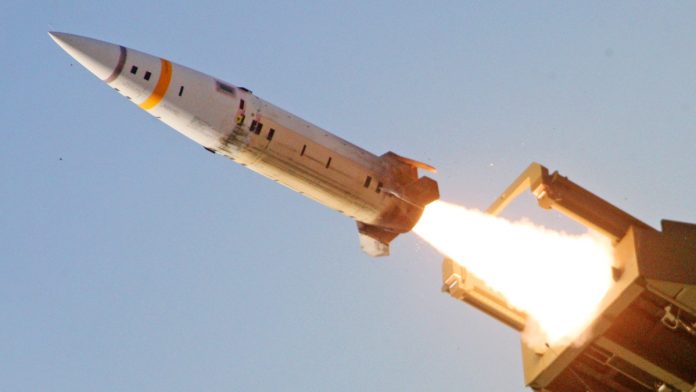Ukraine announced it launched Army Tactical Missile System (ATACMS) short-range ballistic missiles at military targets in Russia. The attack appears to be the first use of these U.S.-made weapons into Russia under the Trump administration. It also points to the strong possibility that another batch of the prized missiles have been supplied to Ukraine, which is noteworthy in itself due to the limited U.S. stocks of the weapons, and/or that the White House has approved the type’s use once again.
“This is a significant development that underscores Ukraine’s unwavering commitment to its sovereignty,” the Ukrainian Armed Forces General Staff said of the attack. “Despite the ongoing pressure of Russian offensive actions, Ukrainians remain resilient, demonstrating determination and consistent resolve in defending their homeland.”

“The use of long-range strike capabilities, including systems such as ATACMS, will continue,” the Armed Forces General Staff added.
Ukrainian officials provided no details about the ATACMS targets or how many were launched. Newer variants of these missiles can reach to nearly 200 miles, with first generation models having just over half the range.
Ukrainian and Russian mibloggers suggested that Ukraine attacked locations in Russia’s Voronezh region, among them the Pogonovo training area, located roughly 105 miles from the border. However, there is no independent verification of that.

The following video, first published by the Supernova+ Telegram channel, purports to show one of the ATACMS being shot down.
Cluster warheads packed with submunitions would be an ideal weapon to fire at a location where troops might be concentrated in the open. Ukraine used cluster munitions-equipped ATACMS to hit a Russian training ground in the occupied Luhansk region in May 2024 to devastating effect. That strike was also captured on video, which you can see below.
Though Kyiv claimed it will continue using ATACMS, just how many it has left is a mystery. Considering the long stretch between known uses, it likely ran dry for an extended period of time until the U.S. supplied more. The Trump administration could have also blocked the use of the weapons, especially into Russian territory, until now, although we cannot confirm this at this time.
Ukraine still has a number of U.S.-made Army High Mobility Rocket System (HIMARS) and M270 MLRS launchers that fire ATACMs. However, the last of these munitions authorized to be sent to Ukraine by former President Joe Biden arrived in the spring, The Wall Street Journal reported in August. The publication noted that “Kyiv has a small supply left, according to U.S. officials.”
Meanwhile, in March, The Associated Press reported Ukraine ran out of ATACMs. A U.S. official told the wire service at the time that “Ukraine was given fewer than 40 of those missiles overall and that Ukraine ran out of them in late January.”
We cannot confirm that number, but we do know they were not furnished by the many hundreds or anything approaching that number. The U.S. inventory is thought to be the low thousands.
Senior U.S. defense leaders, including the previous Pentagon chief, Lloyd Austin, “had made it clear that only a limited number of the ATACMs would be delivered and that the U.S. and NATO allies considered other weapons to be more valuable in the fight,” according to the AP.

As we previously reported, the first tranche of about 20 early generation, shorter-range ATACMS variants arrived in Ukraine in October 2023 and were apparently mostly used during attacks on Russian-held airfields the same month. Ukraine has used the limited number of these prized weapons it has received with major results. Longer-range variants, which were not introduced into the war until the Spring of 2024, were first used in a wave of attacks on air bases and air defense installations across the Crimean peninsula, according to the Kyiv Post.
A major reason for the limited number of ATACMS given to Ukraine is that U.S. officials have expressed concern about their own stockpiles. However, in December 2023, the U.S. Army began receiving the first tranches of the Precision Strike Missile (PrSM) short-range ballistic missiles. The Army, which sees PrSMs as the ATACMS successor, said in September 2023 that the advent of these weapons could reduce some of the readiness risks associated with giving Ukraine ATACMS. It is quite possible that PrSM deliveries had freed-up more ATACMS rounds for Ukraine, and, given the chill between the White House and the Kremlin, these weapons would work both as a tactical tool and a strategic message.
This is especially the case as discussions continue regarding the U.S. supplying even more advanced and longer-range weaponry to Ukraine. While Trump has seemed to sour on giving Ukraine Tomahawk cruise missiles, more ATACMS, which have far shorter range and do not set a new precedent, would be a likely alternative.

After meeting with U.S. President Donald Trump in September, Ukrainian President Volodymyr Zelensky said his American counterpart was open to lifting restrictions on Kyiv’s use of American-made long-range weapons to strike inside Russia, according to The Wall Street Journal. Trump didn’t make any commitments to do so, the newspaper reported.
A month earlier, the Journal wrote that the Pentagon had for months “been blocking Ukraine’s use of long-range missiles to strike inside Russia.”
“A high-level Defense Department approval procedure, which hasn’t been announced, has prevented Ukraine from firing ATACMS missiles against targets in Russia since late spring,” the Journal added. “On at least one occasion, Ukraine sought to use ATACMS against a target on Russian territory but was rejected.”
The last recorded case of a Ukrainian ATACMS strike inside Russia was on January 14 as part of a massive attack also using U.K.-made Storm Shadow air-launched cruise missiles and long-range drones. That took place in the waning days of the Joe Biden administration, which also took a circuitous route in giving Ukraine ATACMS and then allowing them to strike inside Russia. The following graphic, produced as Biden was debating allowing Ukraine to hit Russia with ATACMS, gave a sense of what kinds of targets could be reached.

The first such attack took place almost exactly a year ago. On Nov. 19, 2024, a munitions storage facility near the town of Karachev in the Bryansk region of western Russia was hit by ATACMS. The target was around 70 miles from the Ukrainian border, well within range of these missiles.
There are many questions unanswered about Ukraine’s claimed ATACMS strike today. We have reached out to the White House, Pentagon and State Department to see if we can get some answers about the last time Ukraine was given these weapons and the last time they were used in Russia. We will update this story if they give us any useful details.
While ATACMS did have major lasting battlefield effects, it never proved to be a game-changer based on the tiny quantities provided. But they are another long-range weapon that has existed in Ukraine’s arsenal that packs a punch far heavier than the long-range drones Kyiv has been using across Russia. With Ukraine’s introduction of home-made cruise missiles, this equation is changing, but still, ATACMS are survivable and hit very hard when equipped with a unitary warhead and its cluster warheads can blanket large areas with explosions and shrapnel.
If the strike occurred as stated today, it points to a shift in the Trump administration’s policy when it comes to long-range strikes with U.S. weapons into Russia and it could also indicate the ATACMS supplies are flowing once again.
Contact the author: howard@thewarzone.com







